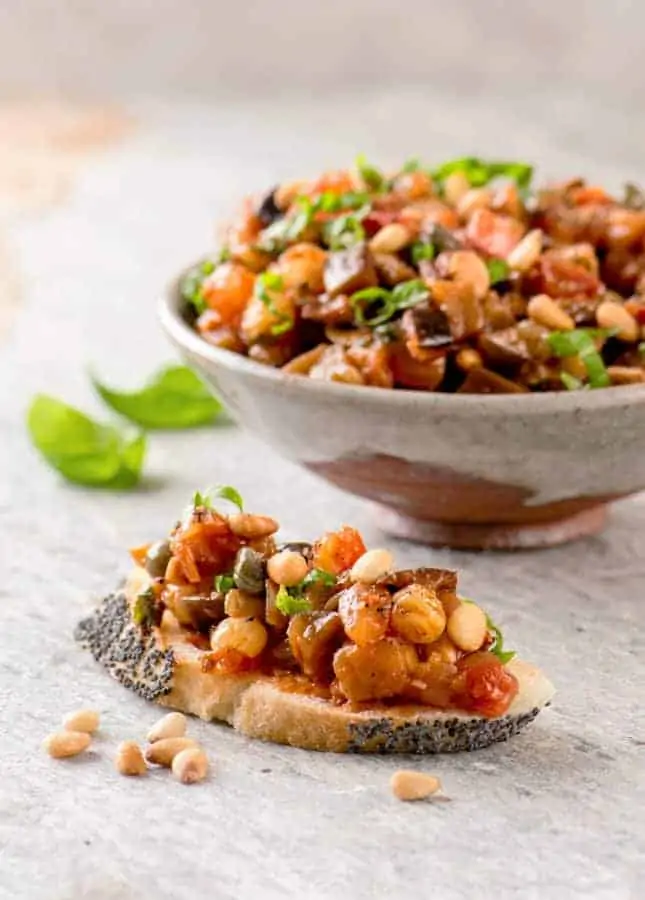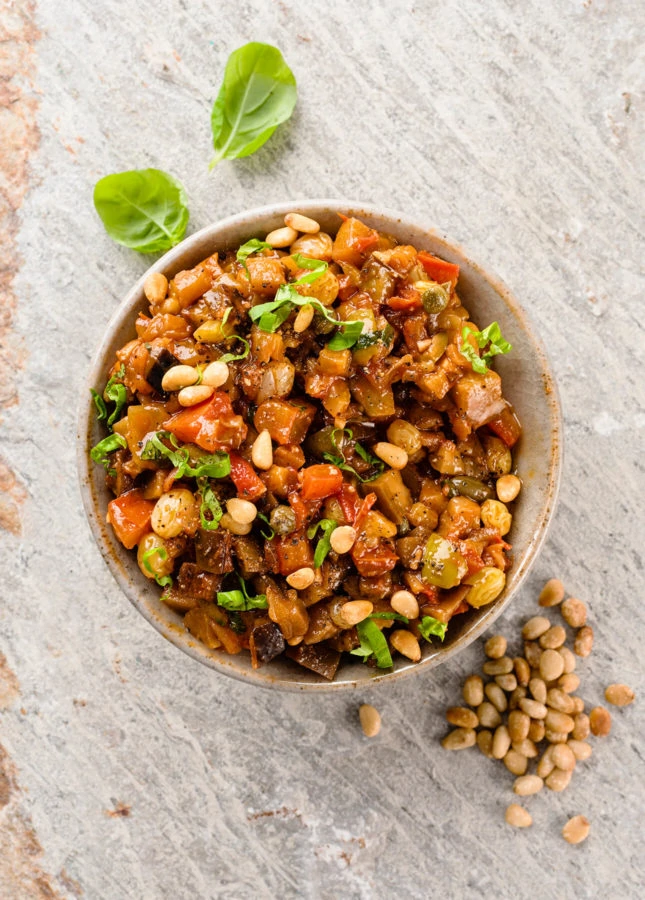- V
- GF
- NS
- DF
- View Recipe Key
How to Make Sicilian Caponata
How to Make Sicilian Caponata
Sicilian caponata is an aromatic vegetable dish that combines sweet and sour ingredients. Learn how to make it and serve it in countless ways!
This post contains affiliate links. Full disclosure is at the bottom of the article.
When I traveled to Sicily for the first time 10 years ago, caponata is one of the first traditional dishes I tasted. Although I ate countless other magnificent dishes through the trip, caponata remained the recipe I most looked forward to making at home. You see, before I tasted caponata, I thought I didn’t like eggplant, but the creamy, chunky, sweet and sour creation that is Sicilian caponata completely changed my mind.
What Is Caponata?
Caponata is a Sicilian sweet and sour version of ratatouille. It is usually made with eggplant and tomatoes and seasoned with celery, raisins, olives, and capers. The combination of sweet and sour ingredients creates agrodolce, a traditional sauce of Italian cuisine. Agrodolce is made by simmering sweet and sour ingredients together. Balance is essential to achieve the best agrodolce flavor: in Sicilian Caponata, sweetness comes from the raisins and a bit of sugar, and the sourness from the vinegar, capers, olives, and a teaspoon of cocoa powder. Yes! Cocoa powder plays an essential role in caponata, but not to worry: the dish doesn’t taste like chocolate in the least. Cocoa deepens the overall flavor of caponata and gives it an intriguing earthy aroma.
In caponata, eggplant is diced then fried in oil, which both concentrates the flavor of the vegetable and gives it a lovely, creamy texture. If you can find smaller eggplants for your Sicilian caponata, go for it: their flavor is sweeter and the skin is thinner, which makes the eggplant indiscernible in the caponata. But most months of the year, the only variety of eggplant I can find where I live is the large, deep purple one, and it works perfectly fine. If you dice it finely and fry it properly, the flavor and texture of that eggplant variety will be just as enjoyable.
How to Serve Caponata
The caponata I enjoyed in Sicily featured chopped octopus, which made it heartier and more luxurious. Octopus is a traditional way to garnish caponata in Palermo, Sicily’s capital. It is said that hundreds of years ago, the dish was served to royalty and was primarily made with a fish called the “capone” (hence the name). The dish was later adopted by the people, who replaced the expensive fish with more affordable eggplant. You can also top caponata with chopped hard-boiled eggs, sardines, grilled shrimp, and even lobster, or serve it with grilled fish. More typically, though, it is served cold as an antipasto (appetizer) on grilled bread.
The flavor of Sicilian caponata develops as it rests, so it’s best to make it at least one day in advance and refrigerate it overnight. After resting, the texture of Sicilian caponata will be thick, rich, and creamy, like that of a chutney. The flavor keeps getting better as it ages, and you can easily keep caponata refrigerated for a week.
Helpful Tips for Making Sicilian Caponata
- Spend extra time to properly chop those veggies: While Sicilian Caponata is the very definition of a textured dish, it’s worth making sure you chop all the vegetables, including (and perhaps most importantly) the eggplant, in even, small dice—about ½-inch (3.5 cm) in size. This ensures that the vegetables bits will be the same size as the olives, raisins, and capers that are mixed into the caponata and produce the most delicious texture.
- Enjoy Sicilian caponata as is—or dress it up: Rested caponata is wonderful as is, but if you serve it as an appetizer, dress it up with an extra drizzle of flavorful olive oil, a sprinkle of fresh herbs, and some additional toasted pine nuts. You could also go fully Sicilian with it and add chopped hard-boiled eggs, sardines, grilled shrimp or octopus, and even lobster.
- You should eat caponata any way and every way, really. As an appetizer, caponata is traditionally served with toasted croutons, but you could also warm it up and toss it through pasta, stir in into risotto, add it to sandwiches and burgers, or serve it as a side for grilled fish or chicken. Top warm caponata with a fried egg and serve it with toasted country bread for what might very well become the best brunch ever.

Sicilian Caponata
Ingredients
- 1 eggplant of about 1 lb 454 g, cut into 1/2-in (1.25 cm) cubes
- 1/4 cup + 1 tbsp olive oil
- 1 small yellow onion minced
- 1 celery rib diced
- 2 cloves garlic minced
- 1 tsp 5 ml kosher salt, or fine sea salt
- 2 tbsp 30 ml tomato paste whisked into 2 tbsp (30 ml) water
- 3 plum tomatoes seeded and diced
- 1/4 cup 60 ml, packed pitted and chopped green olives
- 1/4 cup 60 ml golden raisins
- 2 tbsp 30 ml capers, rinsed and drained
- 2 tbsp 30 ml white wine vinegar
- 1 tbsp 15 ml sugar
- 1 tsp 5 ml dark cocoa powder (also called Dutch-processed cocoa powder), sifted
- 1/4 cup 60 ml shredded fresh basil
- 2 tbsp 30 ml toasted pine nuts (see note)
- To serve optional
- Toasted pine nuts see note
- Fresh basil or flat-leaf parsley
- Best-quality extra-virgin olive oil
- Flaky sea salt
- Toasted baguette slices
Instructions
- In a large nonstick saute pan set over high heat, heat 2 tbsp (30 ml) of the olive oil. When the oil is very hot and glistening, fry half the eggplant cubes, tossing occasionally, until browned (about 7 minutes). Transfer to a large plate. Heat 2 tbsp (30 ml) of the remaining olive oil and fry the remaining eggplant cubes. Transfer to the plate with the first batch and reserve.
- Lower the heat to medium and heat the remaining 1 tbsp (15 ml) olive oil to the same pan. Add the onion and celery and cook, stirring often, until beginning to brown, about 7 minutes. Add the garlic, salt, and pepper, and cook 3 minutes more. Add the tomato paste mixed in water and cook, stirring, until caramelized and almost evaporated, 1 to 2 minutes. Add the diced tomatoes and 1/4 cup (60 ml) water and simmer over low heat for 10 minutes.
- Stir in the olives, vinegar, raisins, capers, sugar, and cocoa powder and continue cooking, stirring occasionally, for 10 minutes (add 1/4 cup / 60 ml more water if the mixture seems too dry). Incorporate the reserved fried eggplant and cook 5 minutes more, until the caponata is nice and thick. Transfer to a large bowl, add the basil and pine nuts and toss to combine. Taste the Sicilian caponata and adjust the seasoning, if needed. Let cool to room temperature then store in an airtight container in the fridge overnight et let the flavors fully develop.
- SERVING: Bring Sicilian caponata back to room temperature at least 15 minutes before serving. Garnish with additional pine nuts, chopped herbs, and a drizzle of your best extra-virgin olive oil. Sprinkle with flaky sea salt, if desired. Serve with toasted baguette slices or crackers.
- STORAGE: Keep Sicilian caponata refrigerated in an airtight container for up to 1 week.
- NOTE: To toast pine nuts, preheat the oven to 300°F (150°C). Spread the pine nuts over a baking sheet and bake for 5 to 8 minutes, keeping a close eye on them at all times because pine nuts can burn very quickly.
Did you make this?
Tell me how you liked it! Leave a comment or take a picture and tag it with @foodnouveau on Instagram.
This site is a participant in the Amazon Associates Program, an affiliate advertising program designed to provide a means for the site to earn fees by linking to Amazon and affiliated sites.
If you click on an affiliate link, I may earn advertising or referral fees if you make a purchase through such links, at no extra cost to you. This helps me creating new content for the blog–so thank you! Learn more about advertising on this site by reading my Disclosure Policy.
Author: Marie Asselin





Love love love caponata!!
I'm happy you enjoyed it. I can't believe I forgot to mention it in my email!!
Looking forward to more news of the trip
Ciao
E
Oh Eleonora, you had given me so many great tips, no wonder you forgot one or two! I *almost* got to taste everything you told me about… for the rest, I’ll have to go back! Thanks again for your help, I’ll be writing all about the rest of my trip throughout next week.
Oh, this looks really delicious! I love eggplant…yum! :)
The flavors of caponata are so rich and deep. I’m really happy I was able to bring a little bit of Sicily back home!
I'm so jealous that you just went to Sicily… I love caponata!
The trip was so quick, it feels like a dream! I’m already planning on going back… soon I hope!